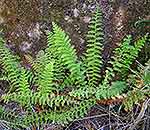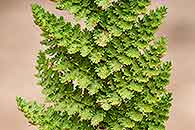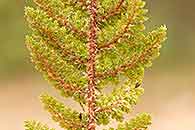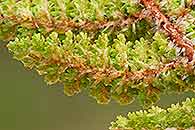Mohria lepigera (Baker) Baker
Synonyms |
Notholeana lepigera Baker |
|---|---|
Common name |
|
Description |
Rhizome shortly creeping, 4-5 mm in diameter; rhizome scales pale brown, up to 5 mm long and 0.9 mm wide, linear to narrowly ovate-lanceolate in outline, margin entire. Fronds few, erect, tufted to closely spaced. Stipe up to 5.7 cm, usually less than 1/4 the lenght of the lamina, pale brown, set with hairs and whitish scales. Lamina 13-48 cm × 2-5.5 cm, oblanceolate to narrowly elliptic in outline, 2- to 3- pinnatifid, with 12-39 pairs of pinnae. Pinnae opposite to alternate, with some much-reduced pinnae basally, ovate to linear in outline. Lower surface of the pinnae sparsely to densely set with hairs and with white, lanceolate, overlapping scales; these are also present on the stipe and rhachis. Upper surface sparsely to densely set with hairs, occasionally with yellow glands. Ultimate segments incised into toothed lobes. Sporangia solitary, submarginal, partly covered by reflexed lobe margin, often obscured by scales. |
Notes | Easily distinguished from other species by the creamy-white scales on the lower surface of the lamina, the generally long and narrow frond outline, the short stipe in relation to the lamina lenght and pinnae that are reduced towards the base of the lamine. |
Derivation | lepigera: scale-bearing, referring to the undersurface of the fronds that are densely covered in scales |
Habitat | Growing on quarzitic soils around the base of boulders or on vegetation islands on granite sheetrock, rocky hillsides, wet evergreen forest, mist forest and montane grassland. |
Distribution worldwide | Africa, Madagascar. |
Distribution in Africa |
Burundi, Dem. Republic of Congo, Malawi, Mozambique, Rwanda, Tanzania , Zambia, Zimbabwe. |
Growth form |
Lithophytic, terrestrial. |
Literature |
|






